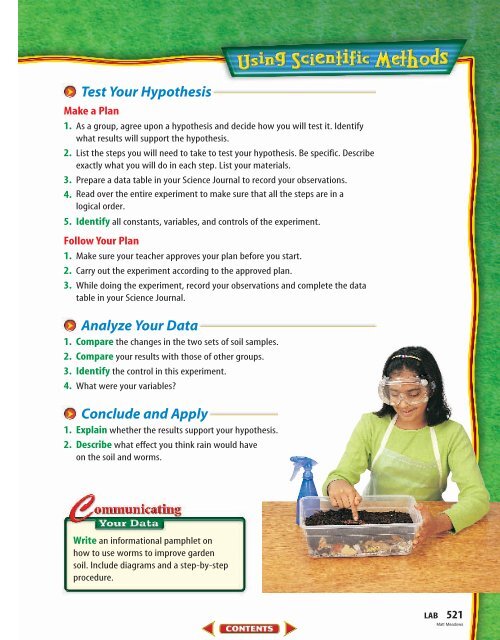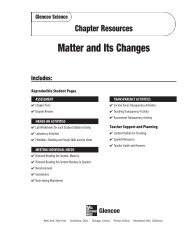Chapter 17: Invertebrate Animals
Chapter 17: Invertebrate Animals
Chapter 17: Invertebrate Animals
You also want an ePaper? Increase the reach of your titles
YUMPU automatically turns print PDFs into web optimized ePapers that Google loves.
Test Your Hypothesis<br />
Make a Plan<br />
1. As a group, agree upon a hypothesis and decide how you will test it. Identify<br />
what results will support the hypothesis.<br />
2. List the steps you will need to take to test your hypothesis. Be specific. Describe<br />
exactly what you will do in each step. List your materials.<br />
3. Prepare a data table in your Science Journal to record your observations.<br />
4. Read over the entire experiment to make sure that all the steps are in a<br />
logical order.<br />
5. Identify all constants, variables, and controls of the experiment.<br />
Follow Your Plan<br />
1. Make sure your teacher approves your plan before you start.<br />
2. Carry out the experiment according to the approved plan.<br />
3. While doing the experiment, record your observations and complete the data<br />
table in your Science Journal.<br />
Analyze Your Data<br />
1. Compare the changes in the two sets of soil samples.<br />
2. Compare your results with those of other groups.<br />
3. Identify the control in this experiment.<br />
4. What were your variables<br />
Conclude and Apply<br />
1. Explain whether the results support your hypothesis.<br />
2. Describe what effect you think rain would have<br />
on the soil and worms.<br />
Write an informational pamphlet on<br />
how to use worms to improve garden<br />
soil. Include diagrams and a step-by-step<br />
procedure.<br />
LAB 521<br />
Matt Meadows














